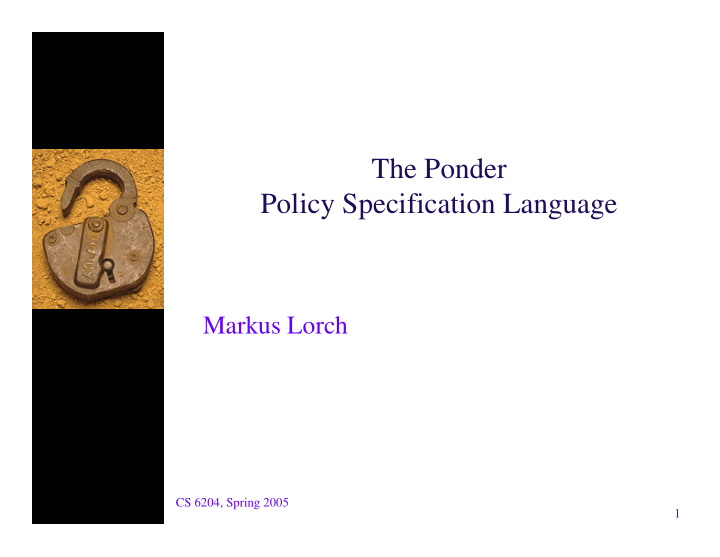



The Ponder Policy Specification Language Markus Lorch CS 6204, Spring 2005 1
Motivation ♦ (security) management for large scale IT systems challenging topic - number of components in enterprise-wide networks and distributed systems is high - dynamic computing paradigms like active networks, mobile agents increase security concerns - changes to system behavior should be possible on the fly and not require code changes CS 6204, Spring 2005 2
PONDER Policies ♦ Policies are rules that govern the choices in the behavior of a system ♦ Business agreements (e.g., service agreements) drive the definition of policies. Top level policies are typically abstract and must be refined for implementation in a specific system ♦ PONDER provides a language for the encoding of - management and - security (access control) policies ♦ The PONDER language is declarative and object oriented CS 6204, Spring 2005 3
Requirements for a Policy Language ♦ Support for access control, access right delegation and management activity ♦ Structuring techniques to improve management / scalability of policies ♦ Composite policies to combine/group security and management policies ♦ Able to analyse policies for conflicts and inconsistencies ♦ Extensibility ♦ Comprehensible language CS 6204, Spring 2005 4
Implementation Independence ♦ PONDER policies are implementation independent and need to be compiled (mapped/translated) for a specific system. ♦ Implementation examples for PONDER authorization policies - mapping into Java access control policies - mapping into Windows 2000 security templates and firewall rules - mapping into Linux kernel access controls CS 6204, Spring 2005 5
Structuring Techniques ♦ A PONDER policy consists of a single rule ♦ PONDER policies can be declared directly or via the definition of parameterized policy types. (Reuse of declarations similar to template library) ♦ PONDER supports inheritance for extensibility CS 6204, Spring 2005 6
Structuring Techniques II ♦ Role-based access control allows for the grouping of individuals to improve scalability in large systems ♦ PONDER uses the organizing principle of “Domains” and “Sub-Domains”, which introduce a hierarchical grouping and naming scheme (similar to a directory structure) CS 6204, Spring 2005 7
PONDER Policy Types Autorization Policies ♦ Authorization Policies Can be positive or negative (what subjects may do, or what subjects may not do) Example: inst auth+ switchPolicyOperators { subject /NetworkAdmin; target <PolicyT> /Nregion/switches; action load(), remove(), enable(), disable(); } CS 6204, Spring 2005 8
PONDER Policy Types II Authorization Policies ♦ Information Filtering Policies Allow the filtering of parameters. E.g., to allow different “views” – some users may get more info back than others, but for all users the same rules were evaluated (no duplication of operations necessary) ♦ Delegation Policies Enable the specification of authority to grant rights to others. (grantee, subject, target, action, when, valid) CS 6204, Spring 2005 9
PONDER Policy Types II Authorization Policies ♦ Refrain Policies Define actions that subjects must not perform. Difference to negative access control policy is that these policies are enforced by subject (not by target). Targets are not trusted to enforce this policy. E.g. as target is not interested in protection from subject. CS 6204, Spring 2005 10
PONDER Policy Types III Management Policies ♦ Obligation Policy Defines event-based actions that must be performed. E.g. logging of unsuccessful login attempts (action) after three attempts (event). CS 6204, Spring 2005 11
PONDER Policy Types IV Composite Policies ♦ Provide ability to group/structure policies following organizational structure ♦ Definition of roles (RBAC) - semantic grouping of policies with a common subject (aka role-definition, the subject is the role name, members of a role are defined elsewhere, aka role-allocation) - roles are thus a set of authorization, obligation, refrain and delegation policies ♦ Definition of Relationships define grouping of roles (subject and target of definition can be roles, defining their relationship) CS 6204, Spring 2005 12
What’s missing ? No model on how policies are introduced and 1. applied in a system, this raises questions: - Ponder does not dictate how policies have to be processed / a decision reached (interoperability between different Ponder-based systems is questioned) - Several examples require state to be kept (e.g. event-based policies may need to count events) - What tells the compiler system what state to keep, and for how long, etc…? CS 6204, Spring 2005 13
What’s missing ? II ♦ Policy / Rule combination How (e.g., in what order) are policies processed and how is the output combined ♦ Distributed policy authority, where is stated what policy was issued by whom, seems to rely on trusted repository for which it can enforce access ♦ How are attributes that are set in policy conveyed back to enforcement point CS 6204, Spring 2005 14
Recommend
More recommend